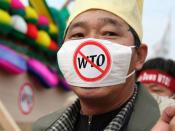The World Trade Organization was established in 1995 to replace the General Agreement on Tariffs and Trade (GATT). The purpose of the organization is to lower tariffs and non-tariff barriers so as to increase international trade. The 146 member states meet in ministerial sessions at least once every two years. The poor countries fear that further liberalization of trade will only benefit rich countries. WTO negotiations favor the interests of investors and neglect agricultural protectionism by rich countries. People criticize that WTO is not very democratic and the poor countries cannot benefit from its negotiation.
The WTO agreements and dispute settlement procedures underpin a rules-based trading system that is essential for small, trade-dependent countries. Countries are encouraged to challenge the bigger and more powerful countries under an independent and judicial nature of WTO proceedings. The WTO dispute settlement procedures system can help the developing countries avoid to damaging protectionist trends in a number of major markets.
Some bigger countries try to force other countries to follow their own regulations and requirements, for example, labor rights, environmental protection, animal welfare, food "safety" and labeling requirements. While the aims of such measures may be valid, without a robust international legal framework there is a high risk of abuse of border requirements for protectionist ends. The developing countries believe that non-tariff technical measures governing trade must be in line with international standards or scientifically justified as provided for by the WTO Agreements on the Application of Sanitary and Phytosanitary Measures (SPS) and Technical Barriers to Trade (TBT).
Since 1997 efforts by member states of the World Trade Organization to negotiate multilateral decisions, at the ministerial level and below, have been less efficient and less legitimate than many would prefer1. Yet proposals for formal changes to decision-making institutions have not achieved consensus. Meanwhile,


